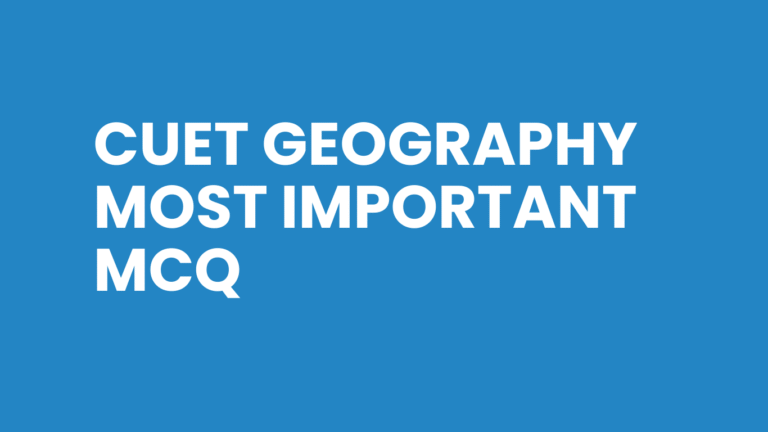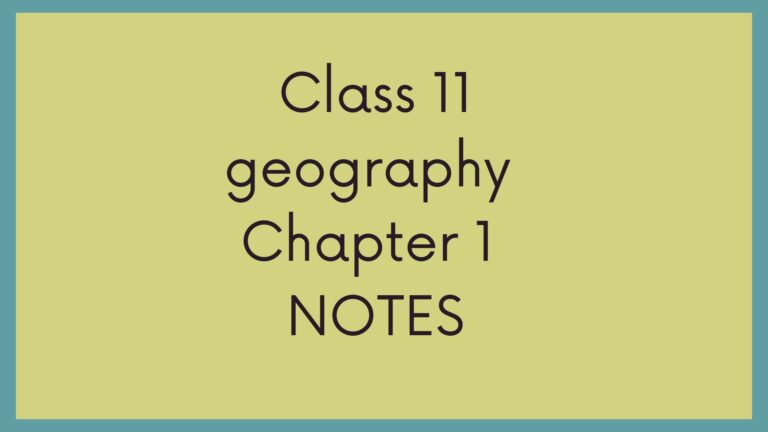Class 12 Geography Chapter 1 Handwritten Notes | Human Geography Handwritten Notes
In this article, you will get Class 12 Geography Chapter 1 Handwritten Notes. You can use this to strengthen your boards preparations.

✍️ Handwritten Notes
Class 12 Geography – Human Geography: Nature and Scope
🌍 1. Introduction
- Geography is the study of earth as the home of humankind.
- It deals with both natural environment and human environment.
- Human Geography: Studies the inter-relationship between humans and nature.
- Focus: How humans adapt to nature, modify nature, and create cultural landscapes.
🌱 2. Evolution of Human Geography
(a) Early Period
- Ancient Greek scholar Eratosthenes coined the term Geography.
- Herodotus, Strabo, Ptolemy contributed to geographical descriptions.
(b) Medieval Period
- Knowledge dominated by religion and explorations.
- Focus on maps, navigation, trade routes.
(c) Modern Period (18th–19th century)
- Human Geography emerged as a separate discipline in the 19th century.
- Influenced by the works of:
- Alexander von Humboldt (founder of modern geography).
- Carl Ritter (Father of Human Geography).
- It became a systematic study of man–nature relationship.
🏞️ 3. Approaches in Human Geography
(a) Environmental Determinism
- Propounded by Friedrich Ratzel.
- Idea: “Nature controls humans.”
- Human life, culture, progress are shaped by climate, soil, relief etc.
- Example: Desert people → nomadic life; Cold areas → limited activities.
- Later supported by Ellen Semple and Huntington.
(b) Possibilism
- Propounded by Vidal de la Blache.
- Idea: “Nature provides opportunities, but humans use them according to needs and culture.”
- Humans are active agents, not passive.
- Role of technology and culture emphasized.
- Example: Japan – limited resources but advanced economy due to technology.
(c) Neo-Determinism (Stop-and-Go Determinism)
- Propounded by Griffith Taylor.
- Idea: A middle path between Determinism and Possibilism.
- Nature provides limits, but humans can decide within those limits.
- Example: Dams can be built, but excess exploitation may cause floods/disasters.
🧑🤝🧑 4. Subject Matter of Human Geography
Human Geography deals with spatial and social aspects of human life.
- Population Geography – study of distribution, density, growth, migration.
- Economic Geography – agriculture, industry, trade, transport.
- Political Geography – boundaries, geopolitics, state & power.
- Social & Cultural Geography – language, religion, traditions, caste.
- Historical Geography – study of past human activities and settlements.
- Medical Geography – health, diseases, epidemics.
🌐 5. Human Geography and Other Disciplines
- Economics: trade, industry, resources.
- Sociology: society, customs, institutions.
- Anthropology: cultures, tribes, evolution.
- History: settlements, civilizations.
- Political Science: nations, states, geopolitics.
Human Geography acts as a bridge between Natural Sciences and Social Sciences.
🏔️ 6. Human–Nature Relationship
- Initially humans were dependent on nature (food, shelter, water).
- With time, humans used technology to modify nature.
- Examples:
- Stone Age → hunting & gathering.
- Agricultural Age → farming & settlements.
- Industrial Age → machines, urbanization.
- Information Age → technology, globalization.
📚 7. Schools of Thought in Human Geography
(a) Deterministic School
- Focus: Nature is dominant.
- Humans adjust passively.
- Example: Eskimos in polar areas.
(b) Possibilistic School
- Focus: Human creativity and technology.
- Humans modify environment.
- Example: Netherlands – reclaimed land from sea.
(c) Neo-deterministic School
- Balance between nature & humans.
- Responsible and sustainable development.
- Example: Renewable energy usage, eco-friendly farming.
🏙️ 8. Changing Trends in Human Geography
- 19th Century – Description of regions, exploration.
- Early 20th Century – Determinism vs. Possibilism debate.
- Mid 20th Century – Quantitative revolution, statistical methods.
- Late 20th Century – Behavioural & welfare approach (focus on quality of life).
- 21st Century – Post-modernism, globalization, environmental concerns.
🗂️ 9. Relevance of Human Geography Today
- Understanding population explosion, migration, urbanization.
- Managing natural resources & environment.
- Planning for economic development.
- Tackling climate change & disasters.
- Promoting sustainable development.
📊 10. Important Thinkers & Contributions
- Eratosthenes: Coined Geography.
- Kant: Geography as synthetic science.
- Humboldt: Modern geography, scientific exploration.
- Carl Ritter: Father of Human Geography.
- Ratzel: Environmental determinism, Anthropogeography.
- Ellen Semple: Spread determinism in America.
- Huntington: Climate & civilization link.
- Blache: Possibilism, Genre de vie.
- Griffith Taylor: Neo-determinism (stop-and-go determinism).
📅 11. Summary of Approaches
| Approach | Proponent | Idea | Example |
|---|---|---|---|
| Determinism | Ratzel, Semple, Huntington | Nature controls humans. | Desert life |
| Possibilism | Vidal de la Blache | Humans modify nature with technology. | Japan’s development |
| Neo-determinism | Griffith Taylor | Balance between nature & humans. | Sustainable use of dams |
✅ 12. Conclusion
- Human Geography studies man–environment relationship.
- Different schools (Determinism, Possibilism, Neo-determinism) explain this relationship.
- Today, focus is on sustainability, globalization, quality of life, and cultural diversity.
- Human Geography helps us understand past, manage present, and plan future.






